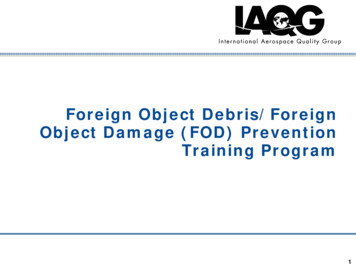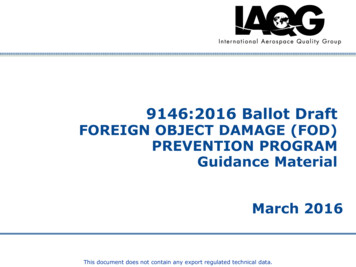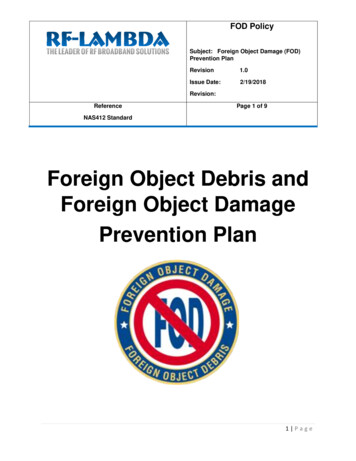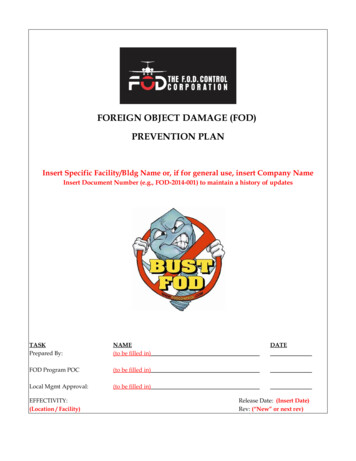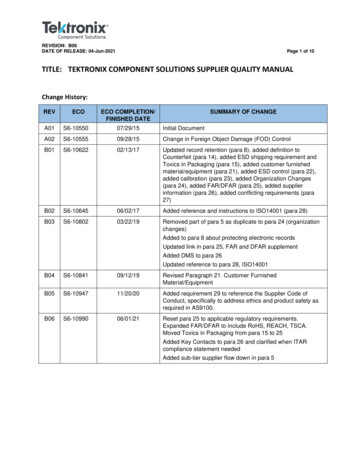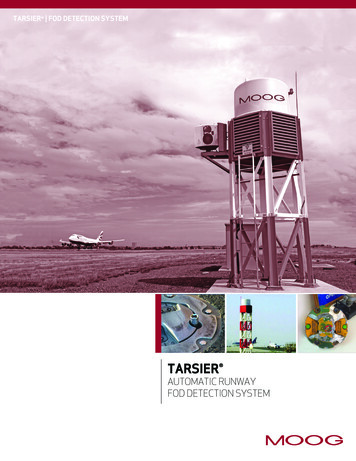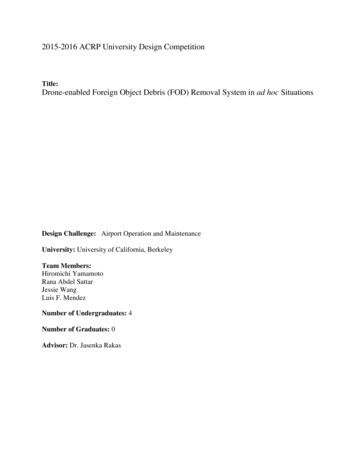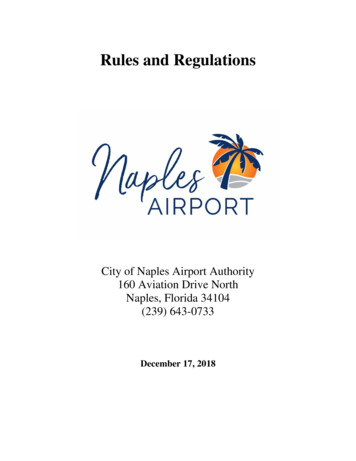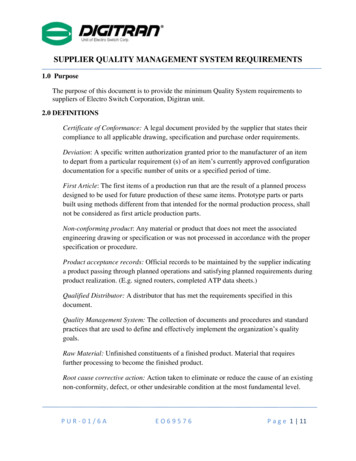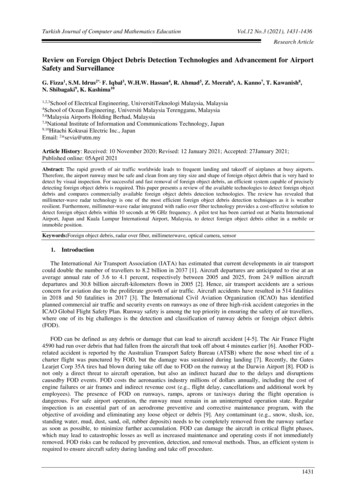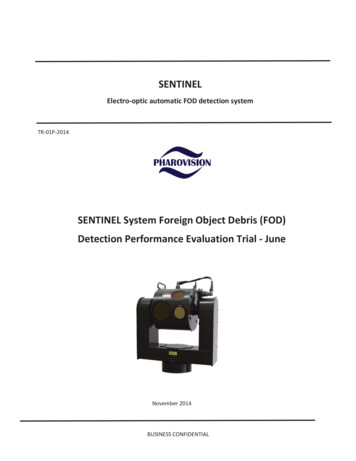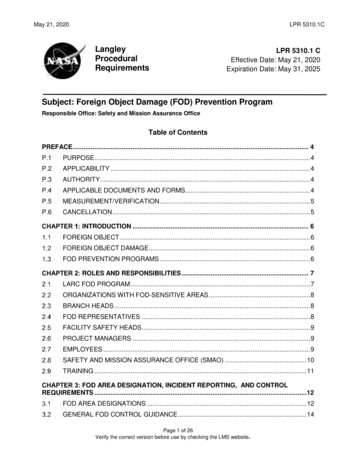
Transcription
May 21, 2020LPR 5310.1CLangleyProceduralRequirementsLPR 5310.1 CEffective Date: May 21, 2020Expiration Date: May 31, 2025Subject: Foreign Object Damage (FOD) Prevention ProgramResponsible Office: Safety and Mission Assurance OfficeTable of ContentsPREFACE . 4P.1PURPOSE . 4P.2APPLICABILITY . 4P.3AUTHORITY. 4P.4APPLICABLE DOCUMENTS AND FORMS. 4P.5MEASUREMENT/VERIFICATION . 5P.6CANCELLATION . 5INTRODUCTION . 6FOREIGN OBJECT . 6FOREIGN OBJECT DAMAGE . 6FOD PREVENTION PROGRAMS . 6ROLES AND RESPONSIBILITIES . 7LARC FOD PROGRAM . 7ORGANIZATIONS WITH FOD-SENSITIVE AREAS . 8BRANCH HEADS . 8FOD REPRESENTATIVES . 8FACILITY SAFETY HEADS. 9PROJECT MANAGERS . 9EMPLOYEES . 9SAFETY AND MISSION ASSURANCE OFFICE (SMAO) . 10TRAINING . 11FOD AREA DESIGNATION, INCIDENT REPORTING, AND CONTROLREQUIREMENTS .12FOD AREA DESIGNATIONS . 12GENERAL FOD CONTROL GUIDANCE . 14Page 1 of 26Verify the correct version before use by checking the LMS website.
May 21, 2020LPR 5310.1CFOD CONTROL METHODS . 14FO/FOD INCIDENT REPORTING . 16LOST ITEMS . 18DESIGN CONSIDERATIONS, ASSEMBLY OPERATIONS, AND MATERIALHANDLING .20DESIGN CONSIDERATIONS . 20ASSEMBLY OPERATIONS . 20MATERIAL HANDLING, PARTS PROTECTION, PACKAGING, AND SHIPPING . 21APPENDIX A: DEFINITIONS .23APPENDIX B: ACRONYMS .25APPENDIX C: REFERENCES .26Page 2 of 26Verify the correct version before use by checking the LMS website.
May 21, 2020LPR 5310.1CChange History LogRevisionCDate10/9/2019Description of ChangeFive-year review. Updated formatting and documentcitations.Page 3 of 26Verify the correct version before use by checking the LMS website.
May 21, 2020LPR 5310.1CPREFACEP.1PURPOSEa.This Langley Procedural Requirements (LPR) sets forth roles, responsibilities,and procedural requirements for the Langley Research Center (LaRC) ForeignObject Damage (FOD) Prevention Program.b.The purpose of the LaRC FOD Prevention Program is to prevent injury topersonnel and to prevent damage to critical hardware, experiments, systems,aircraft, and facilities through proper classification of FOD areas, training ofpersonnel, and implementing appropriate FOD prevention and detectiontechniques.P.2APPLICABILITYa.The LaRC FOD Prevention Program applies to all personnel performingfabrication, assembly, maintenance, operations, and inspections on LaRCaircraft, models, tunnels, facilities, and flight hardware for Center projects whereFOD can potentially cause damage or loss of mission success.b.The program shall be used for operations both at LaRC and away from theCenter.c.In this directive, all mandatory actions (i.e., requirements) are denoted bystatements containing the term "shall.” The terms "may" denotes a discretionaryprivilege or permission, “can” denoted statements of possibility or capability,"should" denotes a good practice and is recommended, but not required, "will"denotes expected outcome, and "are/is" denotes descriptive material.d.In this directive, all document citations are assumed to be the latest versionunless otherwise noted.P.3AUTHORITYa.NPD 8730.5, NASA Quality Assurance Program Policy.b.LAPD 1700.1, Safety Program.c.LAPD 5300.1, Product Assurance Program.d.NASA-STD-6016, Standard Materials and Processes Requirements forSpacecraft.P.4APPLICABLE DOCUMENTS AND FORMSa.LMS-OP-0940, Langley Research Center General Aircraft Maintenance Manualfor Research Services Directorate (RSD).b.LMS-TD-8735, Housekeeping Instruction for the Fabrication of Foreign ObjectDebris (FOD) Free Products in the Fabrication Facilities.Page 4 of 26Verify the correct version before use by checking the LMS website.
May 21, 2020LPR 5310.1Cc.LF 164, Report of LaRC Safety/Health Concern/Close Call.d.LF 360, Foreign Object (FO) and Foreign Object Damage (FOD) Incident Report.e.LF 361, FOD Prevention Survey Checklist.f.LF 588, FOD Awareness Area.g.LF 589, FOD Control Area.h.LF 590, FOD Critical Area.P.5MEASUREMENT/VERIFICATIONa.Compliance with the requirements contained in this LPR will be verified throughperiodic audits conducted by the Mission Assurance Branch, under the Safetyand Mission Assurance Office (SMAO), per Langley Form (LF) 361.b.Compliance with this LPR is verified through responses to the followingquestions:(1)Do organizations have the applicable processes in place that includeprovisions for the prevention, detection, and removal of FO debris?(2)Are inspections conducted in accordance with procedural requirements?(3)Do organizations maintain and verify records of FOD prevention training (e.g.,training attendance sheets), incidents (i.e., LF 360), and corrective actions?P.6CANCELLATIONLPR 5310.1B, dated September 2, 2011David F. YoungMay 21, 2020Deputy DirectorDateDISTRIBUTION:Approved for public release via the Langley Management System; distribution isunlimited.Page 5 of 26Verify the correct version before use by checking the LMS website.
May 21, 2020LPR 5310.1CINTRODUCTIONFOREIGN OBJECTA Foreign Object (FO) is defined as a substance, debris, or article alien to thehardware or system that could potentially cause damage. The object may be foreign toan area or system and may be ingested by or lodged in a mechanism.FOREIGN OBJECT DAMAGEForeign Object Damage (FOD) is defined as any damage attributed to a FO thatcan be expressed in physical or economic terms, which may or may not degrade theproduct’s required safety and/or performance characteristics. Some examples of how aFO causes damage include the ingestion of loose hardware by an aircraft engine, thepassing of debris through wind tunnel blades or causing the short circuiting of flightelectronics, the contamination (e.g., dust, particles) of sensors and optics, the failure ofmechanisms to operate properly due to object obstruction, and the change of physicalproperties of materials (e.g., dissimilar materials) brought on by chemical attack.FOD PREVENTION PROGRAMSMost FOD can be attributed to poor housekeeping, facilities deterioration,improper maintenance, or careless assembly; not keeping full account of hardware,tools, and materials; and inadequate operational practices. An effective FOD preventionprogram identifies potential problems, corrects negative factors, provides programawareness, conducts employee training, and uses industry “lessons learned” forcontinued improvement. A strong FOD prevention program is aligned with LangleyResearch Center (LaRC) management’s commitment to strive for excellence in theconduct of operations to ensure the quality and safety of products and services.Organizational planning and processes shall include provisions for the prevention,detection, and removal of FOs in FOD-sensitive areas.The requirements contained in this document describe the provisions that shallbe followed to ensure the development, implementation, verification, and continuousimprovement of a sound FOD prevention program at LaRC.Page 6 of 26Verify the correct version before use by checking the LMS website.
May 21, 2020LPR 5310.1CROLES AND RESPONSIBILITIESLaRC FOD Prevention ProgramThe Langley Research Center (LaRC) Foreign Object Damage PreventionProgram is designed to prevent injury to personnel and/or damage to critical hardware,experiments, systems, aircraft, and facilities from foreign objects. The organization ofthe LaRC FOD Prevention Program is shown in Figure 2.1. Additional FOD roles andresponsibilities are described in detail below.SMAO, Mission AssuranceBranch HeadDirectors (Sec. 2.2) andBranch Heads (Sec 2.3)* Establish and manageLaRC FOD Program Assign FOD ManagerSFAB, FacilitySystem SafetyEngineer Maintainawareness ofFO/FOD incidentsand correctiveactions in facilitiesDirectors Concur on Risk AssessmentsBranch Heads Assign FOD Representatives Determine FOD classification Implement FOD arearequirementsMAB, FODManager(Sec. 2.8)Project Management (Sec. 2.6) Determine project FOD classificationand communicate FOD requirements Maintain FOD incident documentation Implement FODProgram Conduct FODassessmentsFOD Representatives(Sec. 2.4)MAB, Quality AssuranceSpecialists (Sec. 2.8) Ensure FOD controls areimplemented on flight projects Perform FOD inspections forflight projects as required Maintain FOD sensitive areas Support FOD Program execution,assessments, and notificationsFacility Safety Heads (FSH)(Sec. 2.5)Employees (Sec. 2.7) Perform FOD prevention,detection, and removal Follow FOD reporting andcontrol requirements Conduct FO risk Assessments Assist with determination of FODSensitivity of facility Assist with development ofCorrection Plans* Directors and Branch Heads responsiblefor aircraft, wind tunnels, fabrication,assembly, and test and integration areasneed to address FOD.Figure 2.1: LaRC FOD Prevention Program StructurePage 7 of 26Verify the correct version before use by checking the LMS website.
May 21, 2020LPR 5310.1CORGANIZATIONS WITH FOD-SENSITIVE AREASDirectors of organizations with FOD-sensitive areas shall:a.Be responsible for managing FOD prevention program implementation withintheir organizations.b.Be cognizant of the FOD areas and the assigned levels for areas in theirorganizations.BRANCH HEADSBranch heads with FOD-sensitive areas shall:a.Assign a FOD Representative(s) for their organizations.b.Conduct risk assessments of all their respective work areas to determine theproper level of FOD classification (see Section 3.1). The risk assessment doesnot need to be documented.c.Ensure that proper signage, consistent with the FOD-sensitive area, is posted.d.Determine site-specific FO and FOD control methods, as described in Section3.3 of this LPR, as well as the frequency of any needed inspections, and includethese in the appropriate facility documentation.e.Ensure that all personnel with access to FOD-sensitive areas have theappropriate training and authorization to perform work in each respective area.f.Ensure employees performing work in FOD-sensitive areas follow the assignedFO elimination policies and procedures.g.Implement additional site-specific or project-specific requirements upon requestby the customer.h.Ensure implementation of corrective actions relating to FO prevention, detection,and removal throughout the organization.i.Report any FO or FOD incidents by following the reporting requirements ofSection 3.4 of this LPR.j.Maintain records of site-specific FOD inspections in a manner in which therecords are readily accessible to support audits and assessments.k.Provide records to the FOD Program Manager during periodic FOD PreventionProgram assessments or other Center audits and assessments.FOD REPRESENTATIVESFOD Representatives shall:a.Maintain a listing of all FOD-sensitive areas (e.g., building and room number),and their classifications, under their responsibility and provide the list, and anysubsequent changes, to the FOD Program Manager.b.Perform and document periodic assessments of the execution of the LaRC FODPrevention Program in their respective organizations and provide theassessments of the area to the branch head.Page 8 of 26Verify the correct version before use by checking the LMS website.
May 21, 2020LPR 5310.1Cc.Ensure walk-downs, inspections and site-specific requirements are documentedto show implementation.d.Ensure that the FOD Program Manager is notified of any FO or FOD found, or ofany other FO or FOD related issues, incidents, or concerns.e.Ensure that all Corrective Action Plans identified in LF 360s are completed andimplemented.f.Provide support to the FOD Program Manager during periodic FOD PreventionProgram assessments and other Center audits and assessments.FACILITY SAFETY HEADSFacility Safety Heads (FSHs) shall:a.Assist the branch head when determining the risk associated with a FO for theactivities being performed in an area and the FOD sensitivity designation, perSection 3.1 of this LPR.b.Work with the supervisor and project manager to develop a Corrective ActionPlan for an LF 360 if a FO and/or FOD is found, per Section 3.4 of this LPR.PROJECT MANAGERSProject Managers shall:a.Identify the proper FOD classification per the classification requirements inChapter 3 of this LPR for the project and any project-specific FOD requirements.b.Determine project-specific FO and FOD control methods, as described in Section3.3 of this LPR, as well as the frequency of any needed inspections, and includethese in the appropriate project documentation.c.Ensure project-specific FOD requirements are provided to the appropriate branchhead or implementing organization.d.Ensure all FO and FOD incidents are documented in project records (e.g., workpackages) and investigated, and that corrective actions are taken to preventrecurrence.e.Include design considerations for FOD control to reduce the risk of FOD as a partof their system engineering approach per Chapter 4 of this LPR.EMPLOYEESAll employees who work in FOD-sensitive areas shall:a.Conduct work in a manner that provides for the prevention, detection, andremoval of FOs.b.Obtain an effective understanding of FO and FOD policies and requirements forproject-specific and site-specific work.c.Complete required FOD Prevention Program training designated by eachorganization.Page 9 of 26Verify the correct version before use by checking the LMS website.
May 21, 2020LPR 5310.1Cd.Perform scheduled walk-downs on a frequency determined by managementusing site-specific FOD inspection checklists, as required, and documentcompletion in a manner as directed by management of the organization.e.Report immediately any FO or FOD that is found and any other FO or FODrelated issues or concerns to their immediate supervisors and FODRepresentatives.f.Work with management to help develop specific inspections, control measures,and techniques for FOD-sensitive areas.SAFETY AND MISSION ASSURANCE OFFICE (SMAO)Mission Assurance Branch (MAB) personnel supporting flight projects shall:a.Look for FO and FOD during receipt inspection and quality assurance testing ofsafety critical products.b.Ensure the appropriate FO and FOD controls and inspections are included inproject work packages and procedures.c.Ensure FOD controls are being followed as part of general project qualityassurance duties.d.Ensure FO and FOD incidents are documented in the LaRC NonconformanceReporting (NCR) and Anomaly System and become part of the project workpackage or records.Note: MAB personnel do not support operations in wind tunnels, aircraft, orresearch facilities.The LaRC FOD Prevention Program Manager (FOD Program Manager) shall:a.Oversee implementation of the LaRC’s FOD Prevention Program.b.Update Langley Procedural Requirements (LPR) FOD prevention processes andprocedures, as required.c.Provide FOD Representatives training on the FOD Prevention Programrequirements and changes, as needed.d.Provide general training materials, both for employee awareness and FODPrevention Program requirements, when requested.e.Conduct FOD area assessments with FOD Representatives by evaluating sitespecific FOD inspection checklists, FOD/tool control logs, and FO/FOD incidentreports. Assessments shall also consist of sampling actual FOD-sensitive areasusing Langley Form (LF) 361, and/or assessments of tools and checklist(s)created with approval by the Mission Assurance Branch Head by organizationswith FOD-sensitive areas.f.Record results of assessments and maintain the results in the MAB documentlibrary.g.Arbitrate FO and FOD issues that are not resolved at the supervisor or FODRepresentative level.Page 10 of 26Verify the correct version before use by checking the LMS website.
May 21, 2020h.LPR 5310.1CPerform continuous improvement activities for the LaRC FOD PreventionProgram by staying abreast of changes and improvements in FOD preventionprograms and techniques.Quality Assurance personnel shall:a.Ensure FOD controls are being followed as part of general project qualityassurance duties.b.Include FO and FOD inspections during receipt inspection and quality assurancetesting of safety critical products.c.Perform and sign off on FOD inspections as required by any projectdocumentation.TRAININGSupervisors shall ensure employees directly involved with FOD-sensitive workreceive the appropriate training prior to working in the area and on a biennial recurringbasis thereafter.Training shall consist of briefing the employees of the FOD PreventionProgram content and/or requiring the employees to read and understand the informationcontained in this LPR.Supervisors shall include any specific FO and FOD control techniques,procedures, documentation, and inspections for their respective areas in the requiredtraining for personnel working in those areas.Supervisors shall keep records of all FOD training.The FOD Program Manager shall provide briefing charts, when requested, toprovide clarification of FOD Prevention Program content.Page 11 of 26Verify the correct version before use by checking the LMS website.
May 21, 2020LPR 5310.1CFOD AREA DESIGNATION, INCIDENT REPORTING, AND CONTROLREQUIREMENTSFOD AREA DESIGNATIONSRisk assessments shall be performed for all FOD-sensitive areas using theguidelines in this chapter to ensure proper FOD area designations.Figure 3.1, the guidelines provided in Section 3.1.8 of this LPR, and the factors inSection 3.1.9 provide qualitative guidance to assist in making a risk classification.The designation shall be based on the risk associated with a FO causingfacility/hardware damage during the activities being performed in the area. The riskassessment shall take into account both the consequences and probability a FO will notbe found/controlled.Input from customers and project managers shall be included in determining theFOD area designation.For assistance with determining the risk, branch heads shall consult with the areaFSH or the FOD Program Manager.The level of FOD sensitivity in a given area can increase or decrease based onthe sensitivity and criticality of the system or product being worked on at any given time.Using Figure 3.1 as a guide for combining the two risk factors (i.e., consequenceand probability), FOD-sensitive work areas shall be designated as follows:a.Non-FOD-Sensitive Area: An area where the risk associated with a FO isnegligible and no FOD control measures are needed.b.FOD Awareness Area: An area where the risk associated with a FO resultingin hardware damage/contamination is low.c.FOD Control Area: An area where the risk associated with a FO resulting inhardware damage/contamination is medium.d.FOD Critical Area: An area where the risk associated with a FO resulting inhardware damage/contamination is high.Page 12 of 26Verify the correct version before use by checking the LMS website.
May 21, 2020LPR 5310.1CFigure 3.1: Guidance for combining risk factors(conceptual drawing)Guidelines to be considered when determining the consequences of notdetecting and removing FO are provided below:a.(1)The worst-case damage scenario should be considered. For example, a tool leftin a wind-tunnel test section has the potential to destroy the tunnel blades.Evaluation of this factor is a judgment call that can vary from low to highdepending on several parameters such as the lighting during the inspection,the number of additional times inspection will occur, the number of locationsfor a FO to “hide,” and the physical ease of conducting an inspection.b.Loose parts or tools causing loss of multi-million dollar flight project hardwareshould be considered catastrophic.(1)This factor should be evaluated at the high end of the probability axis ifanswered as “susceptible” or “highly susceptible.”c.Contamination resulting in the need to repeat a low cost experiment may beconsidered minimal.(1)This factor should be evaluated at the high end of the probability axis ifanswered as “susceptible” or “highly susceptible,” or if answered in theaffirmative.d.The consequences of a FO impacting a wind-tunnel fan blade may lie betweenminimal and catastrophic, depending on the monetary loss expected and theprogrammatic impact.Page 13 of 26Verify the correct version before use by checking the LMS website.
May 21, 2020LPR 5310.1CSome factors to be considered when determining the probability a FO will not bedetected and successfully removed are provided below:a.Can a FO be found easily during planned future inspections?b.How susceptible is the product or hardware to damage by a dropped object ortool?c.Is the activity being performed a final close-out inspection of a payload?GENERAL FOD CONTROL GUIDANCEThe following statements are provided to establish general control requirementsto prevent FOD to facilities, aircraft, and quality-sensitive aerospace products beingdesigned, developed, manufactured, assembled, operated, repaired, modified,refurbished, or maintained.Designated FOD-sensitive work areas shall be identified with proper signageusing LF 588, LF 589, or LF 590, as appropriate.Controls for FOD-sensitive area levels shall be established by the branch headusing Section 3.3 of this LPR.Personnel working in FOD-sensitive areas shall comply with the requirements forthat level of sensitivity.Personnel entering FOD-sensitive areas shall be held accountable for itemscarried into those areas.Materials and parts received shall be checked or inspected for FOs and FODprior to use.All visitors entering FOD-sensitive areas shall be trained or escorted by the FODRepresentative or other FOD-trained personnel, as determined by management, andconsistent with the FOD classification area.All tasks shall include the applicable level of provisions for the prevention,detection, and removal of FOs to ensure and preserve the conformity of product andservice to the FOD control methods in this LPR.FOD CONTROL METHODSFabrication facility personnel shall provide housekeeping of fabrication areas toprevent FOD in their facilities and products, per LMS-TD-8735.Hangar complex personnel shall ensure grounds and surfaces on which aircraftand ground support equipment are operated are maintained free of objects that couldcause damage due to ingestion of FOs or jet blast effects, per LMS-OP-0940.All other FOD-sensitive areas shall have site-specific FO and FOD controltechniques documented that meet the requirements of the area designations as statedbelow. Control techniques for a higher level of control can be included in controls for alower level designation.Page 14 of 26Verify the correct version before use by checking the LMS website.
May 21, 2020LPR 5310.1CNon-Sensitive AreasFor Non-Sensitive Areas, customary janitorial practices shall be used tokeep the area clean of trash.FOD Awareness AreasFor FOD Awareness Areas, the following control techniques shall beimplemented:a.FOD Awareness signs shall be posted.b.“Clean-As-You-Go” shall be performed to prevent debris from migrating intoFOD-sensitive areas and hardware.c.Smoking, food, and drink shall be in authorized areas only.d.Walk-downs shall be performed at a periodicity determined by the branch head.e.Tools shall be accounted for at the end of each shift and put away.f.Items shall be cleaned prior to entry into the area to reduce dust or dirt buildup.g.Packaging that minimizes the production of FOs shall be used.h.Unused or spent consumables shall be returned to storage or dispositioned afteruse.FOD Control AreasFor FOD Control Areas, the following control techniques shall beimplemented:a.FOD Control signs shall be posted.b.“Clean-As-You-Go” shall be performed to prevent debris from migrating intoFOD-sensitive areas and hardware.c.Smoking, food, and drink shall be in authorized areas only.d.Walk-downs shall be performed at a periodicity determined by the branch head.e.A tool checklist shall be used to ensure tool accountability.f.Employees shall only take items needed to accomplish a specific task into thework area.g.Unused or spent consumables shall be returned to storage or dispositionedimmediately after use.h.Items shall be cleaned prior to entry into area to reduce dust or dirt buildup.i.Packaging that does not produce FOs shall be used.j.Eyewear, ear protection, loose jewelry, badges, and other personal items shallbe secured.Page 15 of 26Verify the correct version before use by checking the LMS website.
May 21, 2020LPR 5310.1CFOD Critical AreasFor FOD Critical Areas, the following control techniques shall beimplemented:a.FOD Critical signs shall be posted.b.“Clean-As-You-Go” shall be incorporated to prevent debris from migrating intoFOD-sensitive areas and hardware. This includes sweeping and vacuumingfabrication areas, wind tunnel, test cells and rigs, and model build-up areas.c.No smoking, food, or drink shall be allowed in the area.d.Walk-downs shall be performed at a periodicity determined by the branch head.e.Employees shall not bring personal items (e.g., jewelry, keys, and wallets) intothe work area.f.Employees shall not use phones or pagers in FOD Critical Areas unless there isa safety or communication requirement authorized by the branch head.g.Employees shall tether tools and equipment where a dropped article could resultin damage or where it would be difficult to retrieve a dropped item.h.Employees shall contain tools not in use in a tote tray, soft tool bag, or othersuitable spill-proof container, and shall not place tools in a manner that wouldcause damage.i.Employees shall only take items needed to accomplish a specific task into thework area.j.Unused or spent consumables shall be returned to storage or dispositionedimmediately after use. These items shall be stored separately from point of useand carried in sealable containers.k.Hardware (e.g., nuts, bolts, screws, cotter pins, rivets) shall be kitted (i.e.,packaged) by task.l.Items shall be cleaned prior to entry into area to reduce dust or dirt buildup.m.Packaging that does not produce FOs shall be used.n.Eyewear and ear protection shall be secured.o.Tools shall be accounted for after exiting the FOD Critical Area by ensuring thatthey are returned to their proper location through the use of methods such asshadow boards, shadowboxing, bar coding, or special canvas layouts with toolpockets.FO/FOD INCIDENT REPORTINGFor purposes of this LPR, a FO/FOD incident is defined as an instance where aFO is found in a FOD-sensitive area or FOD is found to a facility, aircraft, or qualitysensitive or flight project hardware.Page 16 of 26Verify the correct version before use by checking the LMS website.
May 21, 2020LPR 5310.1CReporting a FO/FOD Incident for Facilities, Wind Tunnels, and Aircrafta.If damage occurs, the event is a mishap. The employee who has found thedamage shall report the incident by dialing 4-SAFE (4-7233) from any Centertelephone or (757) 864-7233 from a cell phone.b.The employee who discovers the debris and/or damage shall notify his/herimmediate supervisor, fill out an LF 360, and submit the completed form to thesupervisor.c.The supervisor shall notify the following persons:(1)FOD Repre
FOREIGN OBJECT A Foreign Object (FO) is defined as a substance, debris, or article alien to the hardware or system that could potentially cause damage. The object may be foreign to an area or system and may be ingested by or lodged in a mechanism. FOREIGN OBJECT DAMAGE Foreign Object Damage (FOD) is defined as any damage attributed to a FO that
